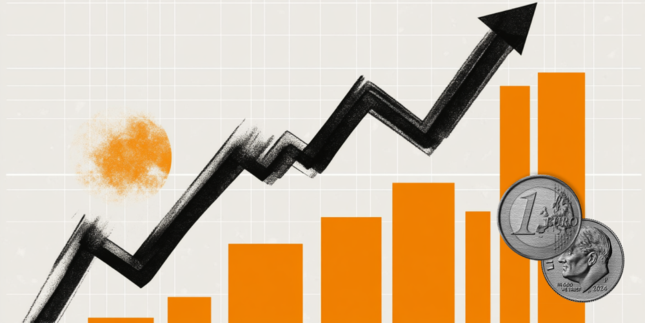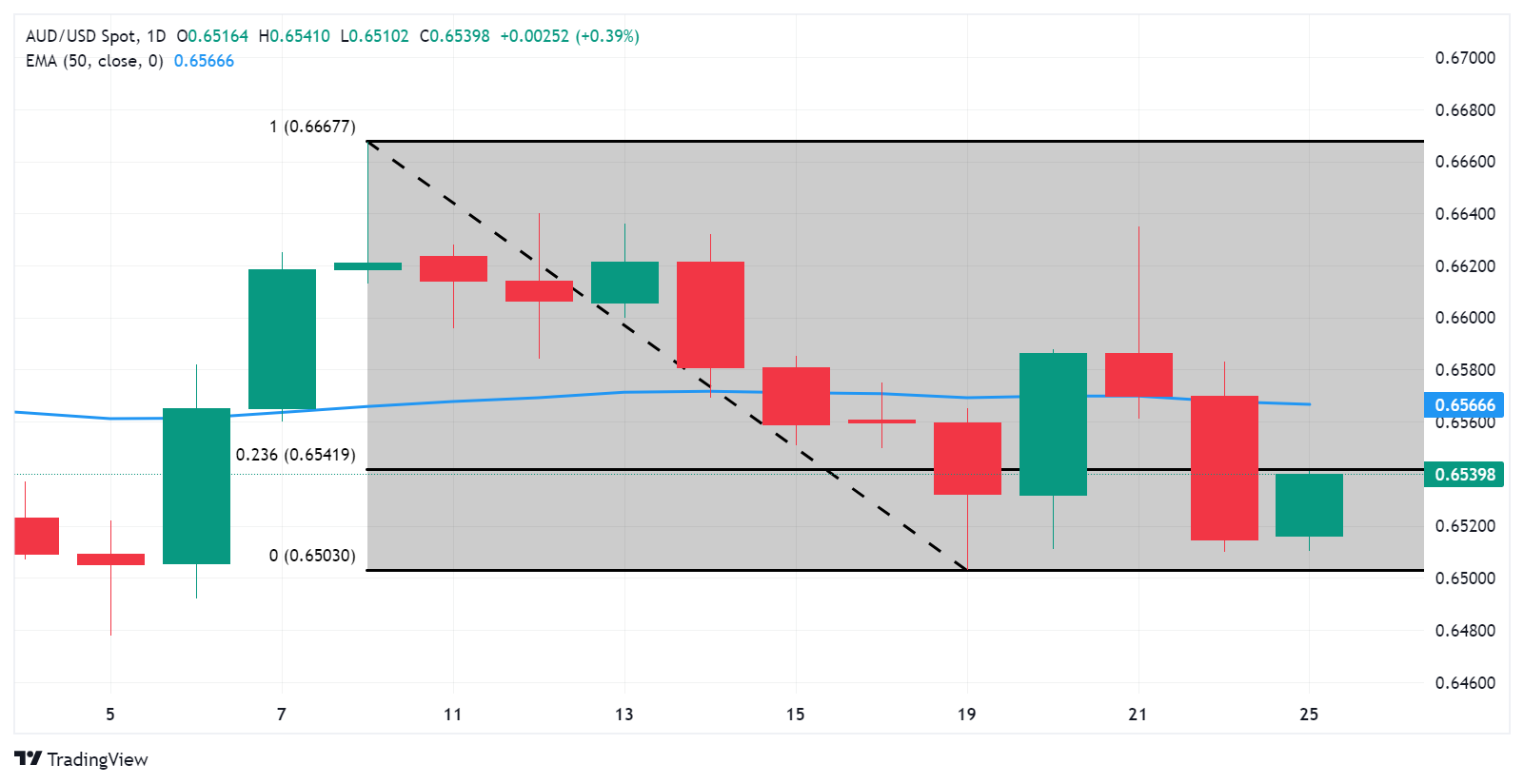- Australian Dollar rises on stronger Chinese Yuan and higher ASX 200 on Monday.
- Australia's government has committed to backing a minimum wage increase aligned with inflation in 2024.
- CNY experienced a significant upward movement due to FX intervention, with Chinese major state banks observed selling USD/CNY.
- Fed Atlanta President Raphael Bostic revised his earlier forecast of two interest rate cuts this year, now expecting only one.
The Australian Dollar (AUD) starts the week by recovering its recent losses registered in the previous session. The AUD/USD pair trades higher on Monday despite a slight decrease in the US Dollar (USD) amid higher US Treasury yields. Investors are expected to closely monitor the Australian monthly Consumer Price Index (CPI) data for February and the US Gross Domestic Product (GDP) for the fourth quarter of 2023.
The Australian Dollar receives upward momentum as the ASX 200 Index extends its winning streak, led by gains in the mining and energy sectors. Additionally, the Aussie Dollar is bolstered by a stronger Chinese Yuan (CNY), with the People's Bank of China (PBoC) setting the mid-rate for the onshore yuan significantly higher than expected.
The US Dollar Index (DXY) undergoes a correction after hitting a five-week high of 104.49 in the previous session. The US Dollar (USD) might face downward pressure as ongoing United States (US) data shapes expectations for the start of the Federal Reserve (Fed) easing cycle, anticipated to commence in June. The Federal Reserve (Fed) has downplayed higher inflation readings, with Chairman Jerome Powell reassuring markets that the central bank will not hastily react to two consecutive months of increased inflation figures.
Daily Digest Market Movers: Australian Dollar appreciates on stronger CNY, ASX 200
- Australian Employment Change for February surged to 116.5K, surpassing expectations of 40.0K and the previous figure of 15.3K.
- Australia’s Unemployment Rate came in at 3.7%, lower than the anticipated 4.0% and the previous 4.1%.
- Australia's government has pledged to support a minimum wage increase aligned with inflation this year, recognizing the ongoing challenges faced by low-income families amid rising living costs.
- China's Premier Li Qiang stated on Sunday that the nation's low inflation rate and low central government debt ratio provide significant leeway for macroeconomic policy adjustments.
- Federal Reserve Bank of Atlanta President Raphael Bostic revised his earlier forecast of two interest rate cuts this year, now expecting only one, citing persistent inflation and stronger-than-expected economic data.
- During the press conference, Fed Chair Jerome Powell stated that an unexpected rise in unemployment could lead the Federal Reserve to consider lowering interest rates.
- S&P Global Services PMI showed a slight decrease in March, dropping to 51.7 from 52.3. The expected reading was 52.0. Manufacturing PMI rose to 52.5 against the expected 51.7 and 52.2 prior. Composite PMI showed a slight dip to 52.2 from 52.5 prior.
- Initial Jobless Claims for the week ending on March 15 came in at 210K, below the 215K expected and 212K prior.
Technical Analysis: Australian Dollar hovers below 0.6540 followed by the 23.6% Fibonacci
The Australian Dollar trades near 0.6530 on Monday. The immediate resistance appears at the 23.6% Fibonacci retracement level of 0.6541, followed by the major barrier of 0.6550 level. A breakthrough above the latter could lead the AUD/USD pair to navigate the area around the 50-day Exponential Moving Average (EMA) at 0.6566, following the psychological barrier of 0.6600. On the downside, the key support appears at the psychological level of 0.6500. followed by March’s low at 0.6477.
AUD/USD: Daily Chart
Australian Dollar price today
The table below shows the percentage change of Australian Dollar (AUD) against listed major currencies today. Australian Dollar was the strongest against the Swiss Franc.
| USD | EUR | GBP | CAD | AUD | JPY | NZD | CHF | |
| USD | -0.07% | -0.05% | -0.09% | -0.14% | -0.01% | -0.14% | 0.03% | |
| EUR | 0.08% | 0.02% | -0.02% | -0.05% | 0.08% | -0.02% | 0.13% | |
| GBP | 0.05% | -0.02% | -0.03% | -0.07% | 0.06% | -0.04% | 0.10% | |
| CAD | 0.08% | 0.01% | 0.03% | -0.04% | 0.10% | -0.01% | 0.14% | |
| AUD | 0.14% | 0.05% | 0.08% | 0.05% | 0.11% | 0.00% | 0.16% | |
| JPY | 0.01% | -0.07% | 0.06% | -0.09% | -0.11% | -0.07% | 0.06% | |
| NZD | 0.08% | 0.06% | 0.09% | 0.05% | 0.01% | 0.14% | 0.20% | |
| CHF | -0.05% | -0.13% | -0.11% | -0.14% | -0.16% | -0.04% | -0.15% |
The heat map shows percentage changes of major currencies against each other. The base currency is picked from the left column, while the quote currency is picked from the top row. For example, if you pick the Euro from the left column and move along the horizontal line to the Japanese Yen, the percentage change displayed in the box will represent EUR (base)/JPY (quote).
Australian Dollar FAQs
One of the most significant factors for the Australian Dollar (AUD) is the level of interest rates set by the Reserve Bank of Australia (RBA). Because Australia is a resource-rich country another key driver is the price of its biggest export, Iron Ore. The health of the Chinese economy, its largest trading partner, is a factor, as well as inflation in Australia, its growth rate, and Trade Balance. Market sentiment – whether investors are taking on more risky assets (risk-on) or seeking safe havens (risk-off) – is also a factor, with risk-on positive for AUD.
The Reserve Bank of Australia (RBA) influences the Australian Dollar (AUD) by setting the level of interest rates that Australian banks can lend to each other. This influences the level of interest rates in the economy as a whole. The main goal of the RBA is to maintain a stable inflation rate of 2-3% by adjusting interest rates up or down. Relatively high interest rates compared to other major central banks support the AUD, and the opposite for relatively low. The RBA can also use quantitative easing and tightening to influence credit conditions, with the former AUD-negative and the latter AUD-positive.
China is Australia’s largest trading partner so the health of the Chinese economy is a major influence on the value of the Australian Dollar (AUD). When the Chinese economy is doing well it purchases more raw materials, goods, and services from Australia, lifting demand for the AUD, and pushing up its value. The opposite is the case when the Chinese economy is not growing as fast as expected. Positive or negative surprises in Chinese growth data, therefore, often have a direct impact on the Australian Dollar and its pairs.
Iron Ore is Australia’s largest export, accounting for $118 billion a year according to data from 2021, with China as its primary destination. The price of Iron Ore, therefore, can be a driver of the Australian Dollar. Generally, if the price of Iron Ore rises, AUD also goes up, as aggregate demand for the currency increases. The opposite is the case if the price of Iron Ore falls. Higher Iron Ore prices also tend to result in a greater likelihood of a positive Trade Balance for Australia, which is also positive of the AUD.
The Trade Balance, which is the difference between what a country earns from its exports versus what it pays for its imports, is another factor that can influence the value of the Australian Dollar. If Australia produces highly sought-after exports, then its currency will gain in value purely from the surplus demand created from foreign buyers seeking to purchase its exports versus what it spends to purchase imports. Therefore, a positive net Trade Balance strengthens the AUD, with the opposite effect if the Trade Balance is negative.
Information on these pages contains forward-looking statements that involve risks and uncertainties. Markets and instruments profiled on this page are for informational purposes only and should not in any way come across as a recommendation to buy or sell in these assets. You should do your own thorough research before making any investment decisions. FXStreet does not in any way guarantee that this information is free from mistakes, errors, or material misstatements. It also does not guarantee that this information is of a timely nature. Investing in Open Markets involves a great deal of risk, including the loss of all or a portion of your investment, as well as emotional distress. All risks, losses and costs associated with investing, including total loss of principal, are your responsibility. The views and opinions expressed in this article are those of the authors and do not necessarily reflect the official policy or position of FXStreet nor its advertisers. The author will not be held responsible for information that is found at the end of links posted on this page.
If not otherwise explicitly mentioned in the body of the article, at the time of writing, the author has no position in any stock mentioned in this article and no business relationship with any company mentioned. The author has not received compensation for writing this article, other than from FXStreet.
FXStreet and the author do not provide personalized recommendations. The author makes no representations as to the accuracy, completeness, or suitability of this information. FXStreet and the author will not be liable for any errors, omissions or any losses, injuries or damages arising from this information and its display or use. Errors and omissions excepted.
The author and FXStreet are not registered investment advisors and nothing in this article is intended to be investment advice.
Recommended content
Editors’ Picks

AUD/USD: Momentum favours further gains
In line with the broad recovery in the risk-linked complex, AUD/USD left behind a two-day negative streak and resumed its uptrend towards the 0.6400 region, always on the back of the resurgence of quite a strong downside pressure hitting the US Dollar on Thursday.

EUR/USD: Extra advances appear in the pipeline
EUR/USD followed the widespread improved sentiment in the risk-linked galaxy and managed to set aside two daily drops in a row and refocus on the upper end of its recent range around the 1.1400 zone on Thursday.

Gold price climbs past $3,300 on uncertainty about trade and weak USD
Gold snaps two-day losing streak, gaining 1.5% on fresh trade war fears. Trump softens tariff talk, but China denies negotiations and demands full rollback. Fed rate cut bets rise as yields drop and economic uncertainty builds.

Ondo Finance hits $3B market cap as CEO Nathan Allman meets SEC to discuss tokenized US securities
Ondo Finance met with officials of the SEC and the law firm Davis Polk to discuss the regulation of tokenized US securities. Topics included registration requirements, broker-dealer rules and proposed compliant models for tokenized securities issuance.

Five fundamentals for the week: Traders confront the trade war, important surveys, key Fed speech Premium
Will the US strike a trade deal with Japan? That would be positive progress. However, recent developments are not that positive, and there's only one certainty: headlines will dominate markets. Fresh US economic data is also of interest.

The Best brokers to trade EUR/USD
SPONSORED Discover the top brokers for trading EUR/USD in 2025. Our list features brokers with competitive spreads, fast execution, and powerful platforms. Whether you're a beginner or an expert, find the right partner to navigate the dynamic Forex market.




